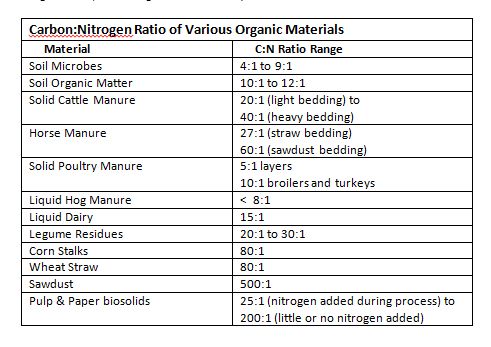“Carbon to nitrogen ratio imbalance” is a term used to describe a type of nitrogen deficiency. A field recently had pulp and paper biosolids applied. The newly planted crop looked great, until the seedlings ran out of seed reserves and started utilizing soil nutrients. The crop then turned a neon shade of yellow. What happened?
When an organic amendment is applied to a field, it adds nutrients and organic matter to the soil. . The carbon: nitrogen (C:N) ratio shows the proportion of organic carbon to total nitrogen of a manure or organic material.
The nitrogen is a food source for the micro-organisms (“soil bugs”) while they break down the carbon material. When the process is complete, the soil microbes die and decompose. The microbial nitrogen is then returned to the soil and becomes available to the plants. This is considered the “organic nitrogen” component of the organic materials. How long this process takes depends on the ratio of carbon to nitrogen in the material.
Liquid hog manure has a C:N ratio near 10:1. The nitrogen in liquid hog manure will become quickly available when the soil microbes are active in the soil. Pulp and papermill biosolids have a C: N ratio ranging from 25:1 to over 200:1, depending on how much nitrogen is added by the company producing the biosolids material. The nitrogen contribution from this material could take considerably more than one growing season to become available. To compensate for the high C: N ratio, some pulp and paper processors will add nitrogen to balance the carbon and reduce the ratio down to about 25:1. Each company provides a different product, so analysis of individual products is important.
P1200442 sample 3b AIM Environmental SSO compost small
Carbon to nitrogen ratio is not obvious by looking at the material. The C:N ratio of this compost material was analyzed at 12:1
The C: N ratio of soil is in the range of 8-10:1. When solid manure or other organic material has a C:N ratio of greater than 30:1, there is a higher risk that the soil micro-organisms will “steal” nitrogen from the soil and tie it up as they break down the carbon, which makes the nitrogen unavailable to a crop. A crop with higher nitrogen requirements, such as corn or wheat, will show nitrogen deficiencies in that situation. When a material has a C:N ratio less than 20:1, there is generally enough nitrogen in the organic material to break down the carbon without causing a nitrogen deficiency in the crop.

Source: Fieldcropnews